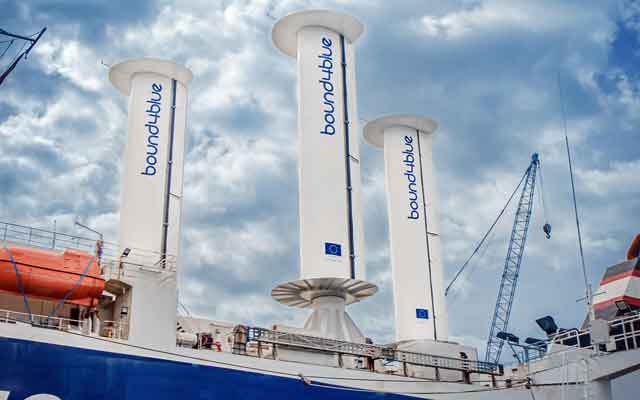According to Spanish eSail developer bound4blue, with wind power emerging as a key enabler for shipping’s green energy transition, the issue of optimising next generation sail technology to deliver maximum commercial and environmental benefits becomes ever more pressing.
The company believes that shipowners and operators must be aware that the aerodynamic efficiency of sails can be affected when multiple units are installed. bound4blue’s DNV Type Approved eSail uses fan systems to prevent the ‘detachment’ of air from its aerodynamic profile, enabling large propulsive force while remaining compact in size. This allows vessels to significantly reduce fuel use, OPEX and pollutant emissions. Recent contracts for eSail installation have been signed with Eastern Pacific Shipping, Louis Dreyfus Company and Odfjell, among others.
Although delighted with the gathering momentum of Wind Assisted Propulsion Systems (WAPS) in general throughout the maritime industry, bound4blue’s team highlights a need to understand how to maximise the efficiency of sail configurations to meet their most ambitious fuel, emissions and regulatory targets.
Marc Martí, Aerodynamic Engineer, bound4blue said: “It’s not as simple as having one WAP unit that generates a power of x and assuming that four sails will produce 4x. When aerodynamic bodies are placed in the vicinity of one another, they impact upon the flow of air around them, disrupting performance. This is an interaction that must be studied, and fully understood, if an owner is to have any chance of optimising the very powerful benefits of wind power. The obvious tool to investigate aerodynamic interference would be Computational Fluid Dynamics (CFD) studies, but these are traditionally incredibly complex, time consuming and expensive. Not something shipowners want to worry about when hunting for easy to adopt technology in an atmosphere of fast evolving, stringent and potentially costly regulations, such as the EU ETS and upcoming FuelEU Maritime.”
bound4blue is introducing what it believes offers a simple way to address this issue. The team has developed a solution known as POINT (POtential INterference Tool), which builds on mathematical modelling and the ‘panel method’, common within the aviation industry, adapting it to the maritime sector and eSAIL characteristics.
Alberto Llopis, Head of Aerodynamics said: “The speed and accuracy of the tool are exceptional. It fast-tracks complex studies that identify the optimal eSail configuration for any vessel, providing a platform for maximising savings, environmental benefits and regulatory compliance. It takes the ‘elephant in the room’ in terms of WAP aerodynamics and shows it the door, solving a key challenge and greatly simplifying the adoption of wind for forward-thinking owners and operators around the world. It’s a clear example of the way we endeavour to provide a better service, and added value, for our customers. We think it will be of huge interest to the industry decision makers at this pivotal time for our industry.”
bound4blue eSails work on the suction sail principle and are said to be suitable for both newbuilds and retrofitting across the majority of vessel segments, including, but not limited to, tankers, bulkers, ro-ros, cruiseships, ferries, gas carriers, and general cargo vessels.
Image: bound4blue eSails (source: bound4blue)



